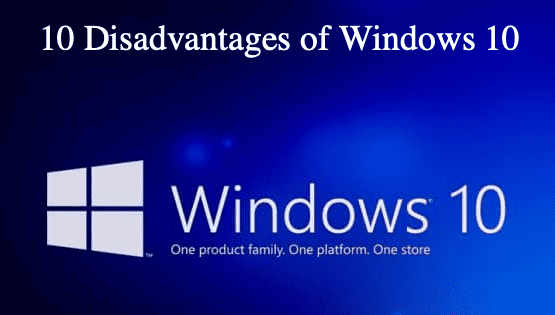
Windows 10, Microsoft’s versatile operating system, has been a cornerstone of modern computing environments. Since its release, it has been lauded for its technology and user experience advancements. However, no technology is without its drawbacks, and Windows 10 is no exception. Users have voiced various concerns, from system performance issues to privacy concerns, impacting their overall experience with the operating system. These disadvantages must be examined to understand the complete picture of what Windows 10 offers and lacks.
Despite its widespread adoption and continuous updates, Windows 10 has not been immune to criticism. Users from various backgrounds and with different usage needs have encountered obstacles that have dampened their enthusiasm for the OS. The spectrum of issues is broad, from professionals dealing with forced updates during crucial work hours to casual users frustrated with the system’s resource demands. This article sheds light on the top 10 disadvantages of using Windows 10, providing a balanced view of its ecosystem.

If you are looking for a pm tool to manage your projects, consider AceProject. This tool is not based on the number of users, which can give you a lot of savings.
Top 10 Cons & Disadvantages of Windows 10
While Windows 10 has brought numerous innovations and improvements, it also carries several significant drawbacks. These cons range from forced updates and privacy issues to compatibility problems and system resource demands. Understanding these disadvantages is crucial for users who rely on their computers for daily tasks, gaming, business, or creative endeavors. This section will delve into each of these disadvantages, highlighting the most common issues faced by Windows 10 users.
1. Forced Updates and System Disruptions
Windows 10’s policy of mandatory updates often leads to unexpected system restarts and work disruptions. Users have no control over when these updates occur, which can be particularly troublesome for those in the middle of important tasks.
- Unexpected System Restarts: Many users report losing unsaved work due to the system rebooting for updates without ample warning.
- Work Interruptions: Critical tasks and meetings are often disrupted due to untimely updates, affecting productivity and workflow.
Resolution: Microsoft could offer a more flexible update system, allowing users to schedule updates conveniently or pause updates for a certain period.
Real-Life Example: A freelance writer once lost several hours of unsaved manuscripts when Windows 10 initiated an update during their writing session. The update disrupted their flow and led to the loss of their creative output for the day.
2. Privacy Concerns
The operating system’s telemetry and data collection features have raised significant privacy concerns. Windows 10 gathers vast user data, often without explicit consent or a clear explanation of its use.
- Data Collection: The extent of personal and usage data collected by default settings raises user privacy issues.
- Lack of Transparency: Users often find themselves unaware of what data is being collected and for what purpose, leading to distrust.
Resolution: Microsoft should provide more transparent privacy settings, allowing users to opt out of data collection and understand the information being gathered.
Real-Life Example: A marketing professional became concerned about their online privacy when they discovered that Windows 10 had been collecting detailed usage data, including search queries and browsing history, potentially exposing sensitive client information.
3. Compatibility Issues
Many users face compatibility issues with older software and hardware, which can be frustrating and costly.
- Software Incompatibility: Older applications, especially those not regularly updated, may not work on Windows 10, causing inconvenience for users.
- Hardware Recognition Problems: Some peripherals, like printers or scanners, may face compatibility issues with Windows 10, leading to additional expenses for replacements.
Resolution: Enhancing compatibility support and providing better guidance for troubleshooting compatibility issues would benefit users greatly.
Real-Life Example: An accounting firm faced significant operational delays when their specialized tax software, which worked perfectly on Windows 7, was incompatible with Windows 10, forcing them to seek costly alternatives.
4. High System Resource Usage
Windows 10 can be resource-intensive, leading to slower performance, especially on older or less powerful hardware.
- Slow Performance on Older PCs: Users with older or less powerful hardware experience sluggish performance and frequent system freezes.
- Increased Power Consumption: The resource-intensive nature of Windows 10 can lead to shorter battery life on laptops and increased energy consumption on desktops.
Resolution: Optimization of the operating system for efficiency and lower resource consumption would help users with less powerful hardware.
Real-Life Example: A student using an older laptop for online classes experienced frequent system lags and crashes with Windows 10, severely impacting their ability to participate in virtual learning environments effectively.
5. Telemetry and Automatic Data Collection
The built-in telemetry features in Windows 10, while intended to improve user experience, often collect more data than users are comfortable with.
- Invasive Usage Tracking: The level of telemetry in Windows 10, including browser history and app usage, can feel invasive to many users.
- Potential Security Risks: The collection and transmission of data pose potential security risks, especially if data breaches occur.
Resolution: More transparent and user-controlled telemetry settings would help alleviate privacy concerns.
Real-Life Example: A privacy-conscious user was alarmed to find that Windows 10 had been automatically sending detailed reports of their app usage and keystrokes, raising concerns about the confidentiality of their communications.
6. Slowdowns and Internet Data Usage
Mandatory updates disrupt work and consume significant internet data, leading to slower performance and additional costs.
- Bandwidth Consumption: Automatic updates can consume significant bandwidth, slowing down other internet activities.
- Data Cap Overages: For users with limited internet data plans, the size and frequency of Windows 10 updates can lead to additional charges.
Resolution: Implementing more efficient update methods and providing options to limit data usage would be beneficial.
Real-Life Example: During a crucial online job interview, a user’s connection became unstable and slow because Windows 10 started downloading a large update, causing significant stress and a poor impression with the potential employer.
7. Bloatware
Windows 10 often comes pre-installed with unnecessary software, taking up valuable disk space and resources.
- Unnecessary Pre-Installed Apps: Windows 10 often comes with several pre-installed applications that many users find unnecessary and intrusive.
- Resource Consumption: These unwanted apps consume system resources, potentially slowing the computer’s performance.
Resolution: Allowing users to uninstall or opt-out of pre-installed software easily would improve the user experience.
Real-Life Example: A new PC user was frustrated to find their brand-new laptop cluttered with unwanted pre-installed apps, which consumed system resources and made navigating the interface more confusing.
8. System Instability
Some users experience system instability and crashes, particularly following updates.
- Post-Update Issues: Updates can sometimes cause system instability, leading to crashes, freezes, or malfunctioning software and hardware.
- Data Loss Risk: System crashes and instability can lead to data loss, especially if users haven’t backed up their work regularly.
Resolution: Thorough testing of updates and providing a reliable system restore option would help mitigate these issues.
Real-Life Example: Following a Windows 10 update, a small business encountered frequent system crashes that disrupted their point-of-sale transactions, leading to customer dissatisfaction and lost sales.
9. Confusing User Interface
New interfaces and features can be confusing and require a learning curve for users accustomed to previous versions.
- Steep Learning Curve: The new design and layout of Windows 10 can be challenging for users accustomed to previous versions of Windows.
- Inefficient Workflow: Adapting to the new interface can take time and effort, potentially reducing productivity, especially for businesses.
Resolution: Offering a more intuitive design or customizable interfaces would help users transition more smoothly.
Real-Life Example: An elderly user, accustomed to the layout of Windows 7, struggled to adapt to Windows 10’s interface, finding simple tasks like locating files and adjusting settings overly complex and time-consuming.
10. Frequent and Inconvenient Updates
The frequency and timing of updates can be inconvenient, interrupting work and personal use.
- Disruption of Personal and Professional Tasks: Frequent updates can interrupt both personal and professional activities, often at inconvenient times.
- Extended Downtime: Some updates require significant installation time, during which the computer may be unusable, causing frustration and delays.
Resolution: A more user-friendly update schedule and allowing users to postpone updates would significantly improve the experience.
Real-Life Example: A graphic designer missed a vital project deadline when their PC unexpectedly went into a lengthy update process, rendering their computer unusable for several hours during their peak productive period.
What is Windows 10?
Windows 10 is a significant release of Microsoft’s Windows NT operating system. It was first released in July 2015 as a significant upgrade from its predecessor, Windows 8.1. Known for its improved user interface, Windows 10 aims to provide a more cohesive experience across various devices, including desktops, tablets, and smartphones.
- User Interface and Features: Windows 10 reintroduced the Start Menu, combining it with Windows 8’s tile-based layout, and introduced new features like the Cortana virtual assistant, the Edge web browser, and multiple virtual desktops.
- Compatibility and Performance: Designed to be compatible with a wide range of hardware, Windows 10 also brought in performance enhancements and regular security updates, making it suitable for personal and professional use.
Windows 10 Studies
Research and user opinions reveal a diverse range of responses to Windows 10. Many users commend its updated interface and innovative functionalities, while some face challenges with compatibility and adapting to the revamped design. Additionally, security analysts have raised points about the privacy aspects and data-gathering methods of Windows 10. This research is essential for comprehending the overall influence of the operating system across varied user groups.
Conclusion
In conclusion, while Windows 10 has been a significant step forward in many aspects, offering an improved interface and a range of new features, it is not without its shortcomings. The top 10 cons and disadvantages highlighted, such as forced updates, privacy concerns, compatibility issues, and high system resource usage, reflect the challenges and frustrations faced by a diverse array of users.
Understanding these drawbacks is crucial for users and professionals in making informed decisions about their operating systems and for Microsoft to continue evolving and addressing these concerns. Ultimately, while Windows 10 has made notable strides in modernizing computing, there remains room for improvement in ensuring it meets the needs and expectations of its wide user base.
Recommended articles: Top 10 Cons & Disadvantages of Windows 11 | Windows 10 vs Windows 11
Daniel Raymond, a project manager with over 20 years of experience, is the former CEO of a successful software company called Websystems. With a strong background in managing complex projects, he applied his expertise to develop AceProject.com and Bridge24.com, innovative project management tools designed to streamline processes and improve productivity. Throughout his career, Daniel has consistently demonstrated a commitment to excellence and a passion for empowering teams to achieve their goals.